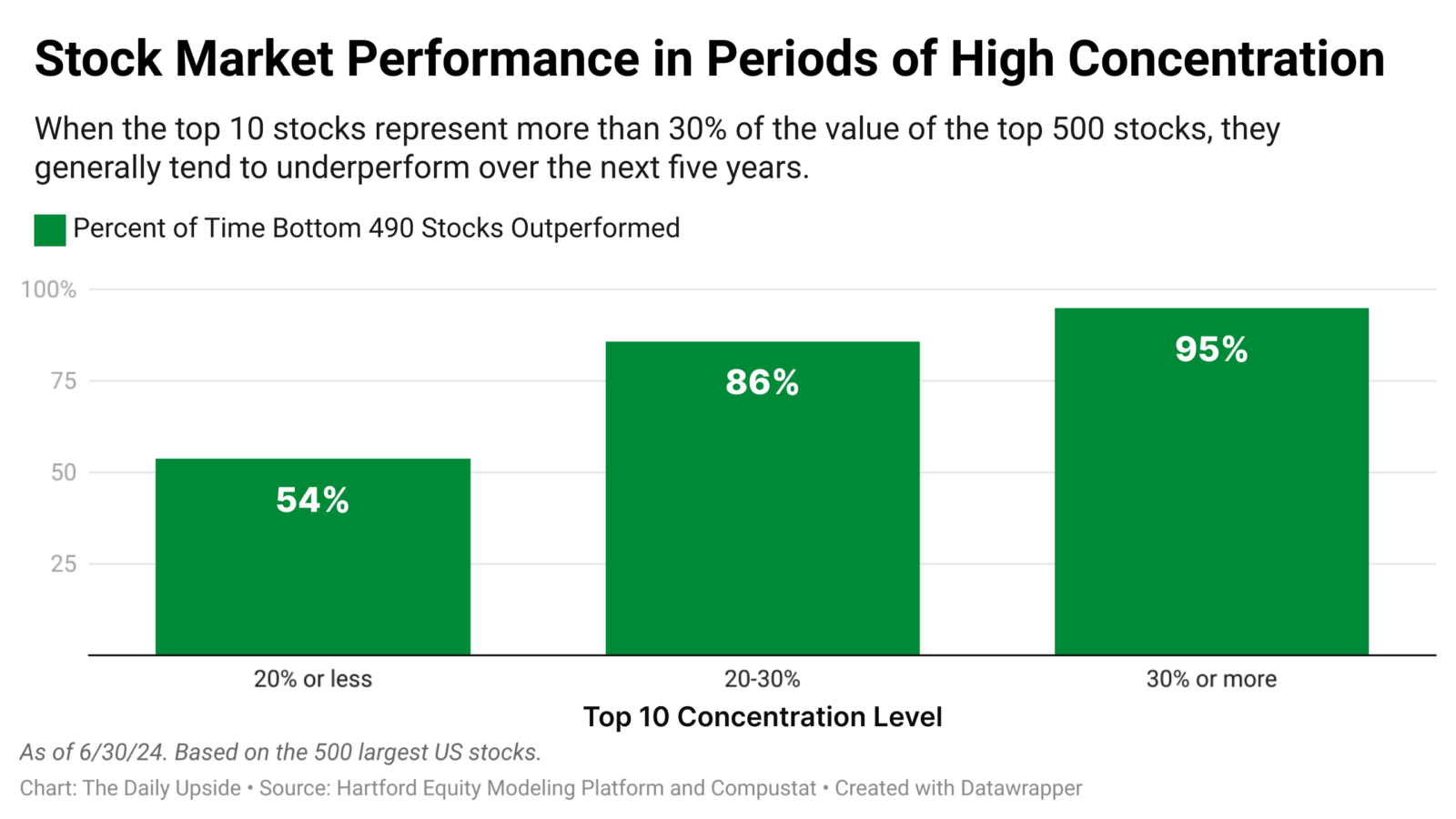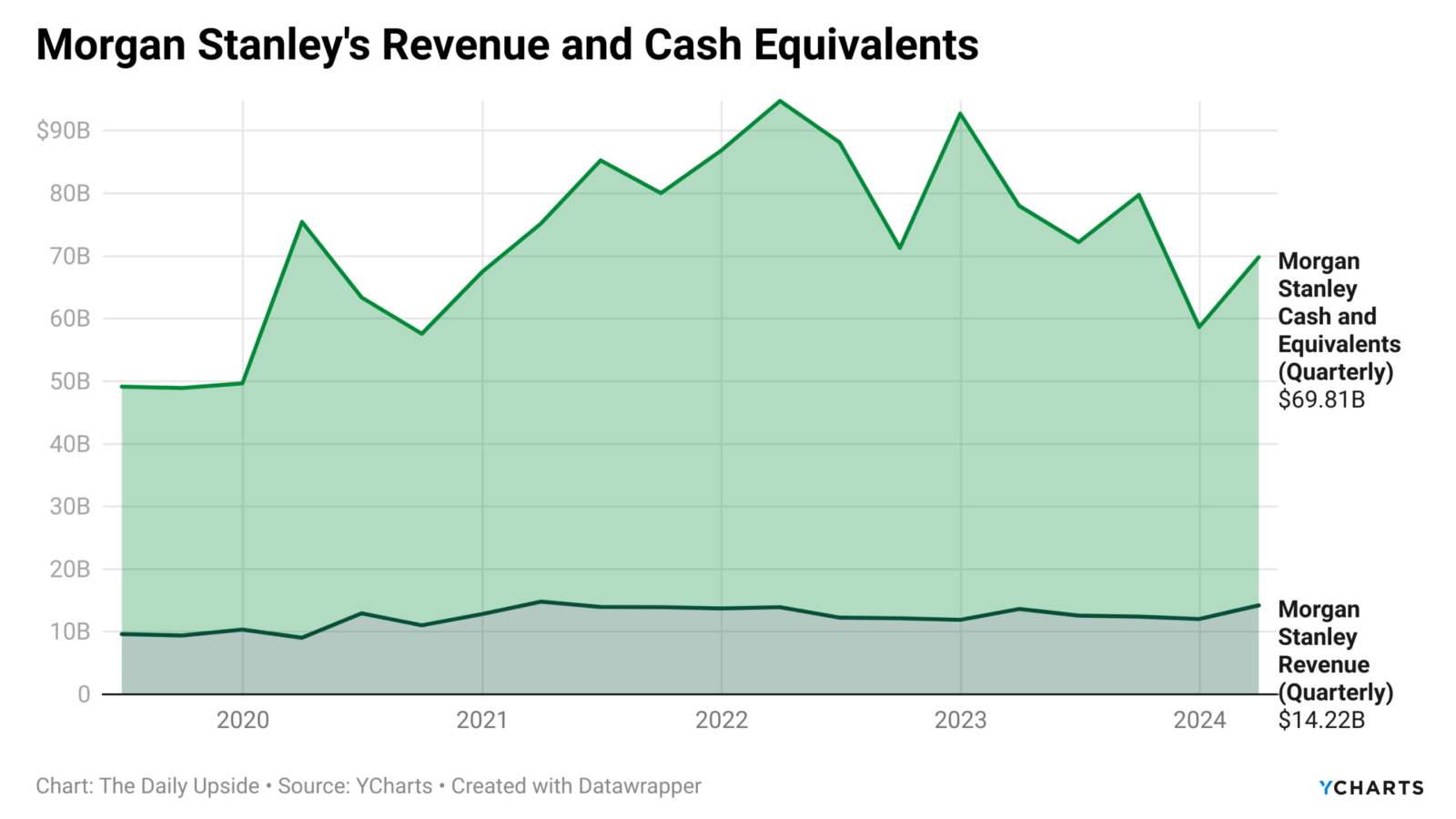Good morning.
Tens of thousands of investors at Vanguard, Fidelity, and other large online brokerages were locked out of their accounts Monday during one of the most volatile trading days since the pandemic. Whoops. More than 15,000 Schwabians reported issues, according to reports. But the problem didn’t appear to impact advisors. Their clients were happily able to trade in and out of positions, as their self-directed peers were left grasping at straws. Sometimes, it feels good to be needed.
Is an Over-Concentrated Stock Market Fueling Volatility?

After a sizzling year, this week’s flash crash was a wake-up call to investors.
Sure, sell-offs are nothing new with market dips of 5% or more occurring at least once a year for the past four decades. But the VIX hit its highest level since pandemic circuit breakers were going off (remember those?) and the highest intraday jump on record on a meaningless Monday in August. With the stock market more heavily concentrated around a handful of stocks than it has been in half a century, those market whipsaws may be here to stay.
The top 10 stocks, including Nvidia and Amazon, now make up 36% of the equity market, according to new research from Hartford Funds. While the powers that be are still hoping for a soft landing, the historical data just isn’t buying it. “The story of concentrated markets has historically had a very unhappy ending,” the report found.
Not From Concentrate
High levels of concentration mean that things can go wrong quickly. One issue is the rise of passive investing. With about half of assets held in index-tracking ETFs and mutual funds, equities are increasingly bought and sold in bulk with little regard to the fundamental earnings of the underlying businesses, according to Christopher Davis, a partner at the New Jersey-based RIA Hudson Value Partners. “As the dust begins to settle, [the drop] seems to be more of a positioning-driven sell-off among quant and highly levered players,” he told The Daily Upside.
Not only are the top 10 stocks more heavily weighted, but they are also increasing at a much higher rate than earnings. This gap between their earnings and weights hasn’t been this great since the height of the dot-com bubble and the 1960s Nifty 50 Bubble before that, according to the research. There are some pretty ominous statistics in the Hartford data:
- When the top 10 companies comprise more than 30% of the largest 500 stocks, the remaining 490 outperform 95% of the time over the next five years.
- High concentration and valuation levels often precedes heightened volatility and pullbacks for the largest stocks.

There are certainly much larger economic forces at play, including global investing strategies like carry trades, which have popped onto the scene this week. And just looking at a single study never paints an entire picture. However, data suggests the stock market may be in for a rocky end of the year.
“This type of volatility will increasingly be a feature of markets,” Davis said. “There will likely be fewer periods in which the ‘fasten seatbelts’ sign will be turned off for investors.”
All That AI. The summer has certainly been tough sledding for this year’s highest-flying, and most concentrated, stocks. The tech segment was one of the hardest hit on Monday: Chipmaker Nvidia was down 6% and Microsoft fell 3%. The tech-focused U.S. Nasdaq 100 index also slipped 3% on Monday and slid 12% from a record high in July, according to Reuters. Investors are antsy that artificial intelligence has simply been overhyped.
“If we listen to what the market is telling us, investors want to see tangible profits from the immense AI capital expenditure spending spree,” Davis said. It’s likely one of the biggest questions that the market will have to answer in the coming years. “We are fortunate to have a client base that [like us] … treats sales as buying opportunities,” he said.
Morgan Stanley Faces SEC Questions Over Cash Sweeps
Morgan Stanley is in the cash-sweep hot seat — again.
The Wall Street investment bank is the latest brokerage to disclose an inquiry over its program of paying paper-thin interest rates to clients on cash. It’s a routine practice by some of the largest broker-dealers that involves shuffling clients’ uninvested assets into higher-yielding accounts. Some reports estimate firms earn profits 10 times what they pay to customers.
Last fall, rival Wells Fargo also disclosed an SEC investigation, and it faces a lawsuit over the practice. Ameriprise and LPL have also been swept up in legal disputes, too, that claim the brokerages did not act in their clients’ best interest. (The next big scoop is finding a broker that’s not getting sued over cash sweeps.)
Cash Me Outside
The Securities and Exchange Commission is now looking into Morgan Stanley’s cash-sweep program, which the investment bank calls its “net income interest.” That revenue grew exponentially to over $8 billion in 2023 alone, according to an unrelated lawsuit filed in June. It’s the second lawsuit the firm is facing over the practice.
To be fair, it’s a commonplace revenue stream that’s often disclosed to investors in the very fine print. Morgan Stanley also offers numerous cash alternatives that clients can choose to invest in. A single basis point interest rate on cash is also an industry standard, and matches rates by competitors like Merrill Lynch and JPMorgan. A basis point saved is a basis point earned, right?
Morgan Stanley declined to comment on the record.

Karma Is on the Menu. Wells Fargo said in its second-quarter earnings call that it would pay customers more on cash and take a likely $350 million hit in its wealth arm this year. Morgan Stanley followed suit, announcing it will now pay its clients 2% on cash, although it’s not clear whether the investigation impacted the decision.
On its most recent earnings call, the company announced a loss in revenue in its sweep accounts. Net interest income for the company topped $1.798 billion for the second quarter, down 17% from a year ago. Morgan Stanley CFO Sharon Yeshaya attributed the drop to “changing competitive dynamics.” The losses are expected to be offset by “repricing” the overall investment portfolio.
India’s Growing Wealthy Are Grabbing Advisors’ Attention
Rupees are ready to be managed in India, and players both at home and abroad are gearing up to court the “Billionaire Raj.”
Last year, the country generated almost $590 billion in new financial wealth, its largest increase in history, according to the Boston Consulting Group. That’s projected to grow to $730 billion annually through 2028. India has quite a few very wealthy citizens, too: 200 billionaires by Forbes’ count. Those impressive projections have grabbed the attention of private-equity firms that are already placing their bets in the country’s wealthtech startups. Analysts see even more opportunity in full-fledged wealth management, and the competition is heating up.
Race to the Top
There’s strength in numbers, and that sounds like a pretty good strategy to the State Bank of India, the nation’s largest lender. SBI, which recently beat analysts’ earnings estimates, is deploying 2,000 executives to act as relationship managers and focus on building ties with smaller companies throughout the nation, according to Bloomberg:
- SBI originally launched its wealth unit in 2016 and now offers the services at roughly 100 major centers across the country through a network of 230 wealth hubs.
- But Chairman Dinesh Khara called the unit “old”; he wants to evolve its business strategy.
And India’s largest wealth manager is also making waves. 360 One WAM acquired mutual fund investing app ET Money for $44 million in June, and is building out a $200 million fund focused on emerging markets.
Journey from the West: American and UK firms are expanding their footprints (and AUMs, of course) in India as well. In April, BlackRock agreed to a joint venture with India’s Jio Financial Services to offer wealth management and brokerage services in the country roughly a year after the two had set up asset management services there. Barclays is aiming to quadruple its private banking assets in Asia by the end of 2028, and is planning a hiring spree, tripling its staff in India and Singapore, Bloomberg reported.
Extra Upside
- “Not Included.” Larry Swedroe, longtime CIO at Buckingham, was a casualty of a merger with the Colony Group in May.
- Settle for Silver? Exchange-traded funds in the US hoovered up $117 billion in July, their second-highest total on record.
- Common Bond: Given high stock market valuations, Vanguard pros think bonds are poised to outpace stocks over the next decade.
Advisor Upside is edited by Sean Allocca. You can find him on LinkedIn.
Advisor Upside is a publication of The Daily Upside. For any questions or comments, feel free to contact us at advisor@thedailyupside.com.
